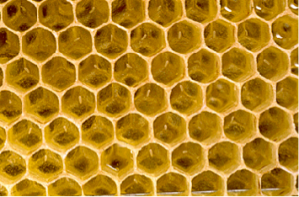‘The Birds and the Bees’ about Bees
I am going to provide a quick summary of the ‘birds and the bees’ about bees in order to explain more about how the Varroa destructor is devastating bee populations.
The queen bee is the only fertile bee in a bee colony and is responsible for all the reproduction activity of a hive. So, the queen is the mother of every bee in a hive, and every bee starts with an egg laid by the queen. The eggs are laid in the honeycomb of the hive; each cell in the honeycomb contains an egg glued to the bottom by the queen. The egg looks like a grain of rice and is 1/8 of an inch long. A larva will hatch from the egg after three days.
After three days, the egg hatches and a young larva emerges. A healthy larva is white and will be in a ‘C’ shape. The worker bees feed the young larvae with royal jelly, which is a secretion from the worker bee glands. The royal jelly is placed on the top of the larvae’s head for easier consumption. After three days, the larvae are fed diluted honey and pollen. The larvae eat the jelly and honey until they have become crowded in their cell. At this point, they stretch out lengthwise, spin a cocoon and enter the pupa stage. The worker bees will then ‘cap’ the cell with a mixture of pollen and wax.
I will end the story here. But consider this… wouldn’t a perfect time for a parasite to feed off of a bee be in the pupa stage when the bee is ‘capped’ off from the rest of the colony?
Disclaimer, this summary is not really about the ‘birds and the bees’ of bee reproduction. I just wanted to catch your attention with a salacious title. I will save the real ‘birds and bee’ story for another entry.
“Brood (honey Bee).” Wikipedia. Wikimedia Foundation, 3 July 2013. Web. 20 Jan. 2014.
Neuenschwander, Bowe. “Honey Bee Information – Brood.” Honey Bee Information – Brood. Bowe’s Honey Bee Site, 08 May 2007. Web. 20 Jan. 2014.
Neuenschwander, Bowe. “Honey Bee Information – Brood.” Honey Bee Information – Brood. Bowe’s Honey Bee Site, 08 May 2007. Web. 20 Jan. 2014.


